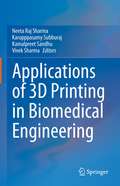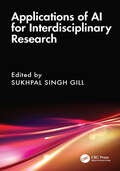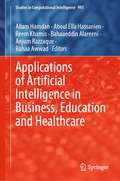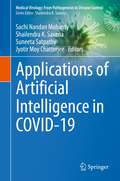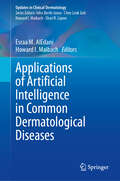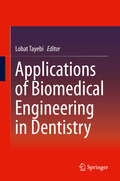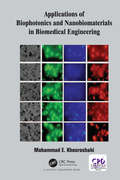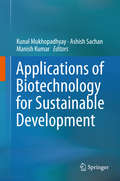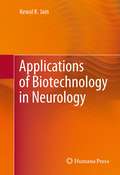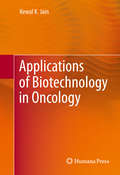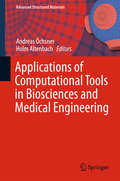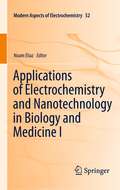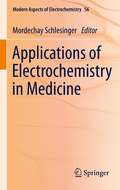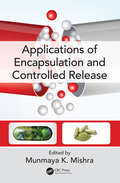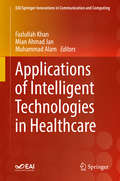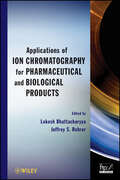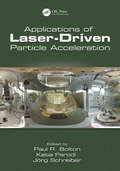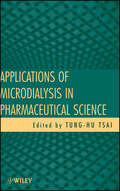- Table View
- List View
Applications of 3D printing in Biomedical Engineering
by Neeta Raj Sharma Vivek Sharma Karupppasamy Subburaj Kamalpreet SandhuThis book focuses on applications of three-dimensional (3D) printing in healthcare. It first describes a range of biomaterials, including their physicochemical and biological properties. It then reviews the current state of the art in bioprinting techniques and the potential application of bioprinting, computer-aided additive manufacturing of cells, tissues, and scaffolds to create organs in regenerative medicine. Further, it discusses the orthopedic applications of 3D printing in the design and fabrication of dental implants, and the use of 3D bioprinting in oral and maxillofacial surgery and in tissue and organ engineering. Lastly, the book examines the 3D printing technologies that are used for the fabrication of the drug delivery system. It also explores the current challenges and the future of 3D bioprinting in medical sciences, as well as the market demand.
Applications of AI for Interdisciplinary Research
by Sukhpal Singh GillApplying artificial intelligence (AI) to new fields has made AI and data science indispensable to researchers in a wide range of fields. The proliferation and successful deployment of AI algorithms are fuelling these changes, which can be seen in fields as disparate as healthcare and emerging Internet of Things (IoT) applications. Machine learning techniques, and AI more broadly, are expected to play an ever-increasing role in the modelling, simulation, and analysis of data from a wide range of fields by the interdisciplinary research community. Ideas and techniques from multidisciplinary research are being utilised to enhance AI; hence, the connection between the two fields is a two-way street at a crossroads. Algorithms for inference, sampling, and optimisation, as well as investigations into the efficacy of deep learning, frequently make use of methods and concepts from other fields of study. Cloud computing platforms may be used to develop and deploy several AI models with high computational power. The intersection between multiple fields, including math, science, and healthcare, is where the most significant theoretical and methodological problems of AI may be found. To gather, integrate, and synthesise the many results and viewpoints in the connected domains, refer to it as interdisciplinary research. In light of this, the theory, techniques, and applications of machine learning and AI, as well as how they are utilised across disciplinary boundaries, are the main areas of this research topic. This book apprises the readers about the important and cutting-edge aspects of AI applications for interdisciplinary research and guides them to apply their acquaintance in the best possible manner This book is formulated with the intent of uncovering the stakes and possibilities involved in using AI through efficient interdisciplinary applications The main objective of this book is to provide scientific and engineering research on technologies in the fields of AI and data science and how they can be related through interdisciplinary applications and similar technologies This book covers various important domains, such as healthcare, the stock market, natural language processing (NLP), real estate, data security, cloud computing, edge computing, data visualisation using cloud platforms, event management systems, IoT, the telecom sector, federated learning, and network performance optimisation. Each chapter focuses on the corresponding subject outline to offer readers a thorough grasp of the concepts and technologies connected to AI and data analytics, and their emerging applications
Applications of Artificial Intelligence in Business, Education and Healthcare (Studies in Computational Intelligence #954)
by Aboul Ella Hassanien Allam Hamdan Anjum Razzaque Bahaaeddin Alareeni Reem Khamis Bahaa AwwadThis book focuses on the implementation of Artificial Intelligence in Business, Education and Healthcare, It includes research articles and expository papers on the applications of Artificial Intelligence on Decision Making, Entrepreneurship, Social Media, Healthcare, Education, Public Sector, FinTech, and RegTech. It also discusses the role of Artificial Intelligence in the current COVID-19 pandemic, in the health sector, education, and others. It also discusses the impact of Artificial Intelligence on decision-making in vital sectors of the economy.
Applications of Artificial Intelligence in COVID-19 (Medical Virology: From Pathogenesis to Disease Control)
by Jyotir Moy Chatterjee Shailendra K. Saxena Suneeta Satpathy Sachi Nandan MohantyThe book examines the role of artificial intelligence during the COVID-19 pandemic, including its application in i) early warnings and alerts, ii) tracking and prediction, iii) data dashboards, iv) diagnosis and prognosis, v) treatments, and cures, and vi) social control. It explores the use of artificial intelligence in the context of population screening and assessing infection risks, and presents mathematical models for epidemic prediction of COVID-19. Furthermore, the book discusses artificial intelligence-mediated diagnosis, and how machine learning can help in the development of drugs to treat the disease. Lastly, it analyzes various artificial intelligence-based models to improve the critical care of COVID-19 patients.
Applications of Artificial Intelligence in Common Dermatological Diseases (Updates in Clinical Dermatology)
by Howard I. Maibach Esraa M. AlEdaniThis book is first authoritative and comprehensive volume that dedicated to the role of artificial intelligence in common dermatological diseases. This book provides up to date and highly illustrated synopsis of the machine learning and convolutional neural network. Chapters address the effective usage of artificial intelligence in common dermatological diseases, and the role of learning machine in each disease, and how it helps in diagnosis and fasten the healing process. For example, It describes the usage of AI in early skin cancer detection, in acne vulgarism grading etc.This book is a valuable resource for dermatologists, medical students, and residents in dermatological specialty.
Applications of Behavior Analysis in Healthcare and Beyond
by Alexandros Maragakis Claudia Drossel Thomas J. WaltzThis timely volume explores the multiple domains where Behavior Analysts can provide meaningful assessment and interventions. Selecting clinical areas in which behavior analysts already are active, chapters will describe unique features of the setting as well as the skills and competencies needed to practice in these areas. While providers of behavior analytic services have substantially increased in number, the field of behavior analysis itself has narrowed. Reimbursement policies and name recognition as a treatment specific to autism have raised concerns that other areas where it is helpful, such as behavioral gerontology or integrated behavioral health, will be de-emphasized. This volume aims to promote workforce development and support broad behavior analytic training, considering the Behavior Analyst Certification Board’s 5th edition task list (effective in 2020).
Applications of Biomedical Engineering in Dentistry
by Lobat TayebiThis book offers readers a valuable overview of recent advances in biomedical engineering, as applied to the modern dentistry. It begins by studying the biomaterials in dentistry, and materials used intraoperatively during oral and maxillofacial surgery procedures. Next, it considers the subjects in which biomedical engineers can be influential, such as 3-dimensional (3D) imaging, laser and photobiomodulation, surface modification of dental implants, and bioreactors. Hard and soft tissue engineerings in dentistry are discussed, and some specific and essential methods such as 3D-printing are elaborated. Presenting particular clinical functions of regenerative dentistry and tissue engineering in treatment of oral and maxillofacial soft tissues is the subject of a separate chapter. Challenges in the rehabilitation handling of large and localized oral and maxillofacial defects is a severe issue in dentistry, which are considered to understand how bioengineers help with treatment methods in this regard. Recent advances in nanodentistry is discussed followed by a chapter on the applications of stem cell-encapsulated hydrogel in dentistry.Periodontal regeneration is a challenging issue in dentistry, and thus, is going to be considered separately to understand the efforts and achievements of tissue engineers in this matter. Oral mucosa grafting is a practical approach in engineering and treatment of tissues in ophthalmology, which is the subject of another chapter. Microfluidic approaches became more popular in biomedical engineering during the last decade; hence, one chapter focuses on the advanced topic of microfluidics technologies using oral factors as saliva-based studies. Injectable gels in endodontics is a new theme in dentistry that bioengineering skills can advance its development, specifically by producing clinically safe and effective gels with regeneration and antibacterial properties. Engineered products often need to be tested in vivo before being clinical in dentistry; thus, one chapter is dedicated to reviewing applicable animal models in dental research. The last chapter covers the progress on the whole tooth bioengineering as a valuable and ultimate goal of many dental researchers.Offers readers an interdisciplinary approach that relates biomedical engineering and restorative dentistryDiscusses recent technological achievements in engineering with applications in dentistryProvides useful tool to dental companies for future product planning, specifically to biomedical engineers engaged in dental research
Applications of Biophotonics and Nanobiomaterials in Biomedical Engineering
by Mohammad E. KhosroshahiThis book provides a link between different disciplines of nanophysics, biophotonics, nanobiomaterials & applications of nanobiophotonics in biomedical research and engineering. The fundamentals of light, matter, nanobiomaterials & nanophysics are discussed together, and relevant applications in biomedical engineering as well as other related factors influencing the interaction process are explicated. Theoretical and experimental research is combined, emphasizing the influence of crucial common factors on applications.
Applications of Biotechnology for Sustainable Development
by Manish Kumar Kunal Mukhopadhyay Ashish SachanThis book discusses different bioprocesses to produce value-added compounds, the science behind their production, the economics of their introduction to the marketplace, their environmental impacts, and their implications for world agriculture. It also provides insights into various technologies and protocols used. The major strength of biotechnology is its multidisciplinary nature and broad range of scientific approaches. Recent advances in various biotechnological fields are facilitating the production of fine chemicals, recombinant proteins, biomaterials and pharmaceuticals. Biotechnology plays an important role, especially in the fields of food production, renewable raw materials and energy, pollution prevention and bioremediation. Biotechnology's greatest contribution is in agriculture - in making crops more efficient. Resource recovery, recycling and hazardous-waste disposal are other environmentally beneficial facets of biotechnology. Thus, biotechnology is a pivotal tool for sustainable development, which has become a priority for the world's policy makers. The concept of sustainable development is based on the goal of increasing the basic standard of living of the world's growing population, without depleting finite natural resources and degrading the environment. Emerging biotechnologies offer novel approaches with the potential to achieve the goal of sustainability and striking a balance between developmental needs and environmental conservation.
Applications of Biotechnology in Neurology
by Kewal K. JainCulling together excerpts from a wide range of writings by Dr. Kewal K. Jain on biotechnology topics as they relate to disorders of the nervous system, Applications of Biotechnology in Neurology covers a variety of applications for those working in life sciences and the pharmaceutical sciences, particularly those developing diagnostics and therapeutics for the nervous system. This detailed volume delves into areas such as neurobiotechnology, like neurogenomics and neuroproteomics, molecular diagnostics, various methods of improving systemic administration of drugs for targeted delivery to the nervous system, including the use of nanobiotechnology, biotechnology-based strategies and products for neuroprotection, as well as chapters on neurosurgery and personalized neurology. Thorough, cutting-edge, and thoughtfully organized, Applications of Biotechnology in Neurology serves as an ideal guide, supplemented by 75 tables and 16 figures as well as numerous references from recent literature on this topic, which are appended to each chapter.
Applications of Biotechnology in Oncology
by Kewal K. JainApplications of Biotechnology in Oncology collects key writings by Kewal K. Jain on the most important contributions of biotechnology to cancer research, particularly to the molecular diagnosis of cancer and drug delivery in cancer for personalized management of patients. Basics of various "omics" technologies and their application in oncology are described as oncogenomics and oncoproteomics. This detailed volume also explores molecular diagnostics, nanobiotechnology, cell and gene therapies, as well as personalized oncology. With approximately one thousand selected references from recent literature on this topic and numerous tables and figures, Applications of Biotechnology in Oncology serves as an ideal reference for oncologists, scientists involved in research on cancer biology, and physicians in various specialties who deal with cancer.
Applications of Biotribology in Biomedical Systems
by Ashwani Kumar Abhishek Kumar Avinash KumarThis book summarizes the past, present, and future work in biotribology with a special emphasis on its applications in the design and manufacture of biomedical devices and their potential future uses. The book covers several aspects of biotribology such as biocompatible materials, joint tribology, skin tribology, oral tribology, tribology of the other human bodies or tissues, animal tribology, plant tribology, medical device tribology, and more. This is an essential reference for academics, biomedical researchers, biologists, tribologists, chemists, physicists, biomedical scientists, materials engineers, mechanical engineers and other professionals in related engineering, medicine, and biomedical industries. This book can also serve as a useful research text for undergraduate and graduate engineering courses such as tribology, materials, biomaterials, material characterization, interface science, and biomedical science.
Applications of Computational Tools in Biosciences and Medical Engineering (Advanced Structured Materials #71)
by Andreas Öchsner Holm AltenbachThis monograph presents the latest developments and applications of computational tools related to the biosciences and medical engineering. Computational tools such as the finite element methods, computer-aided design and optimization as well as visualization techniques such as computed axial tomography open completely new research fields with a closer joining of the engineering and bio/medical area. Nevertheless, there are still hurdles since both directions are based on quite different ways of education. Often even the "language" is sometimes different from discipline to discipline. This monograph reports the results of different multi-disciplinary research projects, for example, from the areas of scaffolds and synthetic bones, implants and medical devices and medical materials. It is also shown that the application of computational methods often necessitates mathematical and experimental methods.
Applications of Computational Tools in Drug Design and Development
by S. N. Koteswara Rao G. Rajasekhar Reddy AlavalaThis book provides a comprehensive overview of the role of computers and computational tools at different stages of drug discovery and development. Designed to meet the needs of a beginner to advanced learner, the book provides the information on the tools, how they work, with the latest reports on applications in drug design, drug delivery and building network pharmacology models. Part I explores the pharmacological aspects, covering computational simulation of drug delivery at the molecular level, modeling for formulation design, and the revolutionary use of computational fluid dynamics in pharmaceutical processes. Specific applications such as pharmaceutical die filling processes, inhalation aerosol-based targeted drug delivery, and the development of inhalation compounds using in silico modeling tools are discussed. The use of computational tools in cheminformatics and their application in preformulation perspectives for drug delivery are also included. Part II expands the scope to include solubility prediction, absorption prediction, protein binding prediction, bio-permeability prediction, toxicity prediction, and metabolism prediction. It covers the identification of potential sites of metabolism in lead molecules and computer-assisted simulation studies to understand drug-polymer interactions. Recent advances in drug likeness screening using software and online tools are also reviewed. Part III focuses on specific therapeutic areas. <span class=
Applications of Dynamical Systems in Biology and Medicine (The IMA Volumes in Mathematics and its Applications #158)
by Trachette Jackson Ami RadunskayaThis volume highlights problems from a range of biological and medical applications that can be interpreted as questions about system behavior or control. Topics include drug resistance in cancer and malaria, biological fluid dynamics, auto-regulation in the kidney, anti-coagulation therapy, evolutionary diversification and photo-transduction. Mathematical techniques used to describe and investigate these biological and medical problems include ordinary, partial and stochastic differentiation equations, hybrid discrete-continuous approaches, as well as 2 and 3D numerical simulation.
Applications of EPR in Radiation Research
by Anders Lund Masaru ShiotaniApplications of EPR in Radiation Research is a multi-author contributed volume presented in eight themes: I. Elementary radiation processes (in situ and low temperature radiolysis, quantum solids); II: Solid state radiation chemistry (crystalline, amorphous and heterogeneous systems); III: Biochemistry, biophysics and biology applications (radicals in biomaterials, spin trapping, free-radical-induced DNA damage); IV: Materials science (polymeric and electronic materials, materials for treatment of nuclear waste, irradiated food); V: Radiation metrology (EPR-dosimetry, retrospective and medical applications); VI: Geological dating; VII: Advanced techniques (PELDOR, ESE and ENDOR spectroscopy, matrix isolation); VIII: Theoretical tools (density-functional calculations, spectrum simulations).
Applications of Electrochemistry and Nanotechnology in Biology and Medicine I (Modern Aspects of Electrochemistry #52)
by Noam EliazThe study of electrochemical nanotechnology has emerged as researchers apply electrochemistry to nanoscience and nanotechnology. These two related volumes in the Modern Aspects of Electrochemistry Series review recent developments and breakthroughs in the specific application of electrochemistry and nanotechnology to biology and medicine. Internationally renowned experts contribute chapters that address both fundamental and practical aspects of several key emerging technologies in biomedicine, such as the processing of new biomaterials, biofunctionalization of surfaces, characterization of biomaterials, discovery of novel phenomena and biological processes occurring at the molecular level.
Applications of Electrochemistry in Medicine (Modern Aspects of Electrochemistry #56)
by Mordechay SchlesingerMedical Applications of Electrochemistry, a volume of the series Modern Aspects of Electrochemistry, illustrates the interdisciplinary nature of modern science by indicating the many current issues in medicine that are susceptible to solution by electrochemical methods. This book also suggests how personalized medicine can develop.
Applications of Encapsulation and Controlled Release (Encapsulation and Controlled Release)
by Munmaya K. MishraThe field of encapsulation, especially microencapsulation, is a rapidly growing area of research and product development. Applications of Encapsulation and Controlled Release offers a broad perspective on a variety of applications and processes, including, up-to-date research, figures, tables, illustrations, and references. Written at a level comprehensible to non-experts, it is a rich source of technical information and current practices in research and industry.
Applications of FDG PET in Oncology: Best Clinical Practice
by Hiroyuki Nakamura Hirofumi Fujii Seiei YasudaThis book provides up-to-date guidance on the use of FDG PET to assess the biological activity and treatment response of a wide range of malignancies, including, for example, lung cancer, breast cancer, head and neck cancer, gastrointestinal cancer, and malignant lymphoma. In the era of precision medicine, numerous new anticancer agents, such as molecular targeted agents and immune checkpoint inhibitors, have been developed to improve outcomes in cancer patients. FDG PET plays a key role in evaluating the effects of these novel treatments because it can detect changes in the metabolic activity of tumors before any reduction in their size is visible on other imaging modalities. Accordingly, FDG PET is of prognostic as well as diagnostic value, and allows prompt changes in patient management. The book is written by expert clinicians from Japan, where the universal public health insurance system ensures that FDG PET is widely used in routine oncological practice and cancer screening. It represents an unrivaled and comprehensive resource that will be of value for all healthcare professionals in the field of clinical oncology.
Applications of Intelligent Optimization in Biology and Medicine: Current Trends and Open Problems (Intelligent Systems Reference Library #96)
by Aboul-Ella Hassanien Crina Grosan Mohamed Fahmy TolbaThis volume provides updated, in-depth material on the application of intelligent optimization in biology and medicine. The aim of the book is to present solutions to the challenges and problems facing biology and medicine applications. This Volume comprises of 13 chapters, including an overview chapter, providing an up-to-date and state-of-the research on the application of intelligent optimization for bioinformatics applications, DNA based Steganography, a modified Particle Swarm Optimization Algorithm for Solving Capacitated Maximal Covering Location Problem in Healthcare Systems, Optimization Methods for Medical Image Super Resolution Reconstruction and breast cancer classification. Moreover, some chapters that describe several bio-inspired approaches in MEDLINE Text Mining, DNA-Binding Proteins and Classes, Optimized Tumor Breast Cancer Classification using Combining Random Subspace and Static Classifiers Selection Paradigms, and Dental Image Registration. The book will be a useful compendium for a broad range of readers--from students of undergraduate to postgraduate levels and also for researchers, professionals, etc. --who wish to enrich their knowledge on Intelligent Optimization in Biology and Medicine and applications with one single book.
Applications of Intelligent Technologies in Healthcare (EAI/Springer Innovations in Communication and Computing)
by Muhammad Alam Fazlullah Khan Mian Ahmad JanThis book covers topics related to medical practices from communications technology point of view. The book provides detailed inside information about the use of health informatics and emerging technologies for the well-being of patients. Each chapter in this book focuses on a specific development in the use of informatics in healthcare. In general, each chapter uses various emerging technologies such as Internet of Things (IoT), Big Data, Cloud computing, Wireless Body Area Networks (WBAN), for various health-related illness, such as tuberculosis, heart diseases, asthma and various epidemic outbreaks. The book is intended both for communications engineers with a healthcare focus and medical researchers.
Applications of Ion Chromatography in the Analysis of Pharmaceutical and Biological Products
by Lokesh Bhattacharyya Jeffrey S. RohrerThis is a comprehensive source of information on the application of ion chromatography (IC) in the analysis of pharmaceutical drugs and biologicals. This book, with contributors from academia, pharma, the biotech industry, and instrument manufacturing, presents the different perspectives, experience, and expertise of the thought leaders of IC in a comprehensive manner. It explores potential IC applications in different aspects of product development and quality control testing. In addition, an appendix section gives information on critical physical and chromatographic parameters related to IC and information on current manufacturers of IC systems, columns, and other components.
Applications of Laser-Driven Particle Acceleration
by Paul Bolton Katia Parodi Jörg SchreiberThe first book of its kind to highlight the unique capabilities of laser-driven acceleration and its diverse potential, Applications of Laser-Driven Particle Acceleration presents the basic understanding of acceleration concepts and envisioned prospects for selected applications. As the main focus, this new book explores exciting and diverse application possibilities, with emphasis on those uniquely enabled by the laser driver that can also be meaningful and realistic for potential users. It also emphasises distinction, in the accelerator context, between laser-driven accelerated particle sources and the integrated laser-driven particle accelerator system (all-optical and hybrid versions). A key aim of the book is to inform multiple, interdisciplinary research communities of the new possibilities available and to inspire them to engage with laser-driven acceleration, further motivating and advancing this developing field. Material is presented in a thorough yet accessible manner, making it a valuable reference text for general scientific and engineering researchers who are not necessarily subject matter experts. Applications of Laser-Driven Particle Acceleration is edited by Professors Paul R. Bolton, Katia Parodi, and Jörg Schreiber from the Department of Medical Physics at the Ludwig-Maximilians-Universität München in München, Germany. Features: Reviews the current understanding and state-of-the-art capabilities of laser-driven particle acceleration and associated energetic photon and neutron generation Presents the intrinsically unique features of laser-driven acceleration and particle bunch yields Edited by internationally renowned researchers, with chapter contributions from global experts
Applications of Microdialysis in Pharmaceutical Science
by Tung-Hu TsaiDiscover new and emerging applications for microdialysis in drug evaluationMicrodialysis is a highly valuable sampling tool that can be used in vivo to measure free, unbound analyte concentrations located in interstitial and extracellular spaces. This book explores the full range of clinical applications for microdialysis, focusing on its use in different organ and tissue systems for pharmacokinetic and pharmacodynamic studies. Readers gain a full understanding of the underlying science of microdialysis, current techniques and practices, as well as its many applications in pharmaceutical research.Applications of Microdialysis in Pharmaceutical Science starts with an introduction to basic principles and then covers analytical considerations, pharmacodynamic and pharmacokinetic studies, clinical aspects, and special applications. Topics include:Role of microdialysis in drug development, including crucial sampling considerations and applications for nervous system diseasesContinuous measurement of glucose concentrations in diabeticsApplications for clinical evaluation and basic research on organ systems, including monitoring exogenous and endogenous compounds in the lungsPharmacokinetic and pharmacodynamic evaluation of anticancer drugsComparison of microdialysis with imaging approaches to evaluate in vivo drug distributionSpecial applications of microdialysis in studies of cell culture assays, drug-drug interactions, and environmental monitoringThroughout the book, readers will find simple models that clarify complex concepts and easy-to-follow examples that guide them through key applications in pharmaceutical research. In short, this book enables pharmaceutical researchers to take full advantage of microdialysis techniques for the preclinical and clinical evaluation of drugs and much more.
